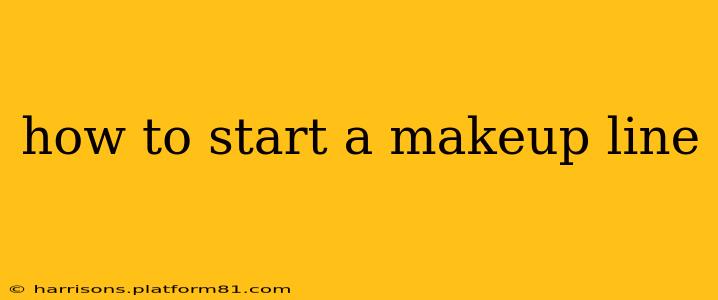Starting your own makeup line is a dream for many beauty enthusiasts, but it's a challenging journey requiring meticulous planning, significant investment, and unwavering dedication. This comprehensive guide will walk you through the essential steps, addressing common questions and offering practical advice to help you navigate this exciting entrepreneurial venture.
What Makes a Successful Makeup Line?
Before diving into the logistics, it's crucial to define your brand's identity and unique selling proposition (USP). What sets your makeup line apart? Is it innovative formulas, cruelty-free practices, sustainable packaging, a specific niche (e.g., makeup for mature skin, vegan makeup), or a compelling brand story? A strong USP will attract loyal customers and differentiate your brand in a competitive market.
Developing Your Product Line: Formulation and Sourcing
This is arguably the most critical stage. Do you want to formulate your own products or work with a contract manufacturer (CM)?
Formulating your own products: This requires significant expertise in cosmetic chemistry and substantial investment in research and development. You’ll need to understand ingredients, regulations, and testing procedures.
Working with a contract manufacturer: This is often a more practical approach, especially for startups. CMs handle formulation, production, and quality control. Research reputable CMs specializing in cosmetics; review their capabilities, minimum order quantities (MOQs), and pricing structures. Be sure to thoroughly vet potential manufacturers to ensure they align with your brand values and quality standards.
Choosing Your Products:
Start small. Don't overwhelm yourself or your budget with a vast product range initially. Focus on a core collection of 3-5 hero products that showcase your brand's identity and address a specific market need. You can expand your line later as your business grows.
Building Your Brand: Name, Logo, and Packaging
Your brand identity is crucial for attracting your target audience. Invest time in developing a strong brand name, logo, and packaging that reflect your brand's personality and values. Consider:
- Brand name: Choose a name that's memorable, easy to pronounce, and relevant to your brand's aesthetic and target market. Check for trademark availability.
- Logo: Create a logo that is visually appealing and easily recognizable.
- Packaging: Choose packaging that is aesthetically pleasing, functional, and aligns with your brand's sustainability goals (e.g., recyclable, eco-friendly materials).
Legal and Regulatory Compliance
Navigating the legal aspects is crucial to avoid future complications. Key considerations include:
- Business registration: Choose the appropriate legal structure for your business (sole proprietorship, LLC, etc.).
- Product labeling: Ensure your product labels comply with all relevant regulations (e.g., ingredient listing, warnings, safety information). Regulations vary by country, so research thoroughly.
- Testing and certifications: Depending on your location and target market, you may need to conduct specific safety and efficacy testing to meet regulatory requirements.
Marketing and Sales Strategy
Getting your makeup line into the hands of consumers requires a well-defined marketing and sales strategy. Consider:
- Target audience: Who are you trying to reach? Understanding your target audience will inform your marketing efforts.
- Marketing channels: Explore various channels, including social media marketing (Instagram, TikTok, Facebook), influencer collaborations, email marketing, and potentially paid advertising.
- Sales channels: Will you sell directly to consumers through your website (e-commerce), via wholesale partnerships with retailers, or through a combination of both?
Funding Your Makeup Line
Securing sufficient funding is a key challenge. Options include:
- Personal savings: This is often the initial source of funding.
- Small business loans: Explore loans from banks or credit unions specifically designed for startups.
- Crowdfunding: Platforms like Kickstarter and Indiegogo can help you raise capital while building excitement around your brand.
- Investors: Seeking angel investors or venture capital may be an option once your business has established traction.
Frequently Asked Questions (PAAs)
How much does it cost to start a makeup line?
The cost varies significantly depending on the scale of your operation, the number of products, your manufacturing choices (formulating in-house vs. using a CM), and your marketing budget. Expect to invest several thousand dollars to hundreds of thousands, depending on your ambitions.
What licenses and permits do I need to start a makeup line?
Licensing and permit requirements vary widely depending on your location and the specifics of your business. Consult with legal and regulatory experts in your area to determine the specific requirements. This includes checking for necessary business licenses, permits for manufacturing cosmetics, and potential import/export licenses if your business spans across international borders.
How do I find a good contract manufacturer?
Thorough research is crucial. Look for manufacturers with experience in cosmetic production, a good reputation, and a track record of quality. Request samples of their work, visit their facilities (if possible), and carefully review their contracts before signing any agreements. Pay close attention to their minimum order quantities (MOQs) and pricing structures to ensure they align with your budget and projected sales.
How do I market my makeup line?
A multi-faceted approach is often most effective. Leverage social media marketing, influencer collaborations, email marketing, and potentially paid advertising to reach your target audience. Building a strong online presence is essential, with a professional website and engaging content. Consider attending industry trade shows and networking with beauty professionals to expand your reach.
How do I ensure my makeup line is safe?
Safety is paramount. Work with reputable manufacturers who adhere to strict quality control standards and conduct thorough testing of your products to ensure they meet regulatory requirements and are safe for consumers. Transparency is key; clearly label your ingredients and disclose any potential allergens or irritants.
Starting a makeup line is a challenging but rewarding endeavor. By carefully planning, diligently executing each step, and continuously adapting to market demands, you can increase your chances of success in this exciting industry. Remember that passion, perseverance, and a strong brand identity are essential ingredients for building a thriving makeup empire.
